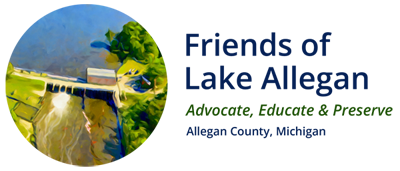Statutory Framework

Part 307, Roadmap to Preserving Lake Allegan
Information provided with permission from Four Lakes Task Force courtesy of Joseph W. Colaianne, General Counsel for Four Lakes Task Force; Feb 2021.
Michigan common law does not require a private dam owner to maintain the existence of a dam or the artificial level of a lake. The 1922 case of Goodrich v. McMillian established the rule that ownership of a dam does not impose a duty on the dam owner to maintain water at an artificial level created by operation of the dam (which contradicts the Lake Allegan Deed restriction stating that Consumers does have a responsibility to maintain a certain lake level). Similarly, in Drainage Board v Village of Homer in 1957 a dam owner was allowed to destroy a dam over the complaints of the riparian landowners that lowering the impoundment would diminish their ability to use sub-surface water for irrigation.
The Court in this case said that the riparian owners were continuously aware by the very fact of the dam and its gates, with notice that the pond is artificial and that it’s level may be lowered or returned to a natural state at any time by the dam owner. Because of the harshness of these laws Part 307 provides a public solution for preserving lakes that were created by the artificial impoundment of water.
Thus Part 307 is the exclusive authority for establishing and maintaining the legal levels of a natural or artificial lake and Section 30701 of Part 307 defines “normal level” of an inland lake as the level or levels of the water that provides the most benefit to the public; that best protects the public health, safety, and welfare; that best preserves the natural resources of the state; and best preserves and protects the value of property around the lake.
The purpose of Part 307 is to provide for the control and maintenance of inland lake levels for the benefit and welfare of the public. The act essentially authorizes counties to make policy decisions as to the levels of their inland lakes, and to build and finance dams as necessary to maintain the desired lake levels but it is the circuit court that has the authority to weigh competing factors in its determination of the normal levels of an inland lake. Additionally, once established the circuit court has continuing jurisdiction over the lake levels, which means anything affecting lake levels, including departure from the normal levels (Citizens for Higgins Lakes Legal Levels v. Rosecommon County Board) should be presented to the court for consideration.
Part 307 also provides the financial model for sustainability of lake level structures. Part 307 authorizes the establishment of a special assessment district to defray the costs in connection with administration, operation, maintenance, and improvement of lake level structures. The special assessment district is authorized to issue municipal bonds and notes up to 40 years, which allows for the spreading of costs to landowners over a longer period and to lower assessments for property owners. This was a recent amendment to Part 307 by the Michigan Legislature.
Part 307 authorizes a county to acquire dams and lake level structures by way of “gift, grant, purchase or condemnation proceedings, an existing dam that may affect the normal level of the inland lake, sites for dams or rights in land needed or convenient in order to implement” Part 307.
Part 307 is the statutory framework for transitioning private dams to public ownership, and a mechanism for long-term sustainability. This is the road map for the preservation of Lake Allegan.
Part 309, Lake Improvement Success
Information excerpted from Allegan County Department, Drain Office.
“Part 309 of the Natural Resources and Environmental Protection Act, (Act 451 of 1994), provides for the improvement of certain inland lakes; authorizes the dredging and removal of undesirable materials from lakes; and authorizes the raising of money by taxation and special assessment to cover improvement costs.
Under Part 309, a local unit of government, by motion or by petition of 2/3 of the property owners abutting the lake, may establish a lake improvement board. By statute, the lake board consists of five (5) members:
- A member of the County Board of Commissioners
- A member of the Lake Association
- The County Drain Commissioner
- A township/city representative
- A representative from the Department of Environmental Quality
The lake board is charged with determining the scope of the improvement project and establishing a special assessment district of all parcels of land and local units, which will be benefited by the improvement of the lake. A registered professional engineer is retained to prepare an engineering feasibility report, an economic study report, an estimate of cost and probable assessments.
In Allegan County, lake improvement boards have been established primarily for aquatic plant control and abatement of water quality issues.
Allegan County has four established lake improvement boards: Hutchins Lake, Lower Scott Lake, Miner Lake, and Gun Lake, which is an intercounty project shared with Barry County.”
